Evangelist as Rock Star: Billy Sunday in Buffalo, 1917
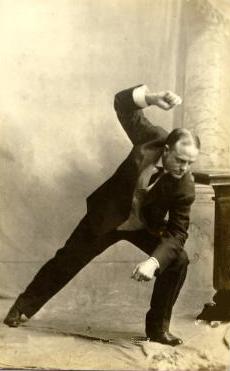
Billy Sunday in a preaching pose.
Image source: billysunday.org
William Ashley "Billy" Sunday, born in Ames, Iowa, was an American phenomenon during his 30 years as a traveling evangelical preacher. A former professional baseball player with the Chicago Whitestockings and Pittsburgh Pirates, he became "born again" at age 29 and left his career as it was approaching its height to travel the "sawdust trail" as the revival circuit was called. His appeal was his preaching style, full of gymnastics, slang and the common touch. He was ordained as a Presbyterian minister, but emphasized that he was not a theologian. "I want to preach so plainly that men can come from the factories and not have to bring a dictionary." He punctuated his preaching with physical gestures often involving his entire body. The pulpits constructed at each of his venues required padding to prevent injury to Sunday when he pounded repeatedly on it. And extra pulpits were constructed at each stop for those occasions when he broke the structure while making a point. Over the years, his themes centered on the evil of alcohol, evolution, movie-going, women's fashions, etc.
By the time Billy Sunday's organization came to Buffalo for eight weeks on January 27, 1917, he had been holding "campaigns" in cities around the U.S. for twenty years. He was at the height of his fame. The Buffalo Evangelical Association had worked for ten years to secure his visit. The intention of the Billy Sunday campaigns was to generate converts in a city; their names would be forwarded to local churches so that they might be "conserved" as regular members.
Sunday's organization was composed of over two dozen staffers, each of whom was experienced in some aspect of preparing a city for a campaign. The first requirement, according to Dr. James E. Walker, Sunday's chief advance man, was the necessity of the host city to raise $40,000, of which he estimated $23,000 was for construction of a temporary "tabernacle" in which the revival preaching would occur.

Olympic Park Baseball Grounds. Image source: 1894 City of Buffalo Atlas
The executive committee of the Buffalo Evangelical Association dithered for months on where to locate the tabernacle. They finally settled on the baseball park at the corner of Michigan and East Ferry, then called Olympic Park. Some committee members favored this location as an ironic tribute to Sunday, who had played there as a Chicago Whitestocking against the Buffalo Bisons in 1888. That settled, a local firm of Graves, Manbert, George & Co. was lowest bidder on construction of the tabernacle and work began on December 4, 1916.

The temporary "tablernacle" on the baseball grounds, 1917. Image source:TBHM
Joseph Speice, Sunday's tabernacle superintendent, provided the plans and specifications for the tabernacle. It was to be a "turtleback" shape, 216' x 302' with 28 entrances on three sides. The inner lobby featured a removable wall to accomodate crowds, two broad aisles down the center were named the "sawdust trails." In the center was the rostrum, a raised platform 6' x 16', behind which was the choir loft 6 feet higher with seating for 2,150 singers. The main floor space had seating for 12,000 (or 14,500 or 16,000). In the end, the tabernacle cost either $25,000 or $33,000 to construct and furnish.
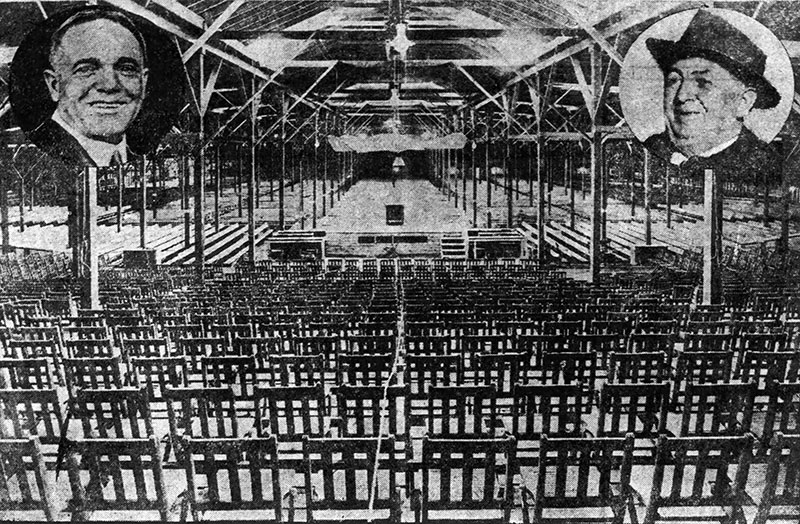
Interior of the tabernacle, 1917. Inset photos:left, Billy Sunday' right, Joseph Spiece, tabernacle builde. Image source: Buffalo Express
Beneath the choir loft was where the machinery of the campaign worked. Offices, rooms for ministers, caretaker, workers, ushers, reporters, lost parcels, toilets. There was a post office and an emergency hospital with three beds and hot and cold running water. Here also was a private bath and rubdown room for Billy Sunday which he said he needed after three-hour revival meetings.
Outside the tabernacle Sunday's organization set up a restaurant operated by his caterer, George E. Taylor, "the man who feeds the multitudes."
The Sunday organization also required the use of a home with 14 bedrooms, a challenge that went unmet until just before his arrival on January 27. Advance man Dr. Walker suggested that, if necessary, the household servants could sleep elsewhere to provide the total rooms necessary. Mrs. Cynthia Bissell, a widow whose husband had been manager of the Wagner Palace Car Works, surrendered her home at 390 Linwood. In addition, the loan of ten automobiles per day for the 8 weeks was required by the Sunday organization; the local chairman of the transportation committee, William Volgamore, said on January 17 that he was having trouble finding enough automobiles.
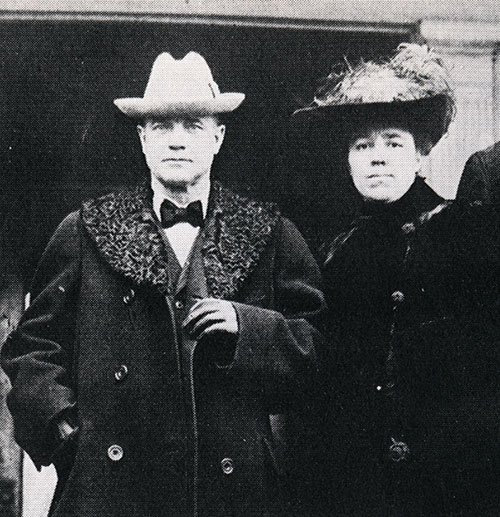
Rev. Billy Sunday and his wife, "Ma", 1917. Image source: TBHM
Numerous committees in Buffalo had been charged with energizing Buffalo residents. Buffalonian George Gowing had to assemble three 2,000 member choirs and train them for Sunday's music director, Homer Rodeheaver. Three hundred people, representing practically all the charities in the city, met at the YMCA to plan ways to round up attendees. Involved in organizing working girls were Mrs. Mary Hubbard Heath, wife of William Heath, Larkin Company executive; Mrs. Horace Reed, Mrs H.E. Montgomery, Mrs A. H. Cook. The YWCA held rallies for school girls. Over 100 Buffalo ministers had pledged themselves to help make Sunday's campaign successful, inluding the Delaware Avenue Baptist Church, the First Presbyterian Church, Pilgrim Congregational Church, Asbury Methodist Church, and the Richmond Avenue Methodist Episcopal Church. They also agreed to cancel Sunday services on the third Sunday of each month in order to free up their parishioners to attend the revival meeting at the tabernacle.
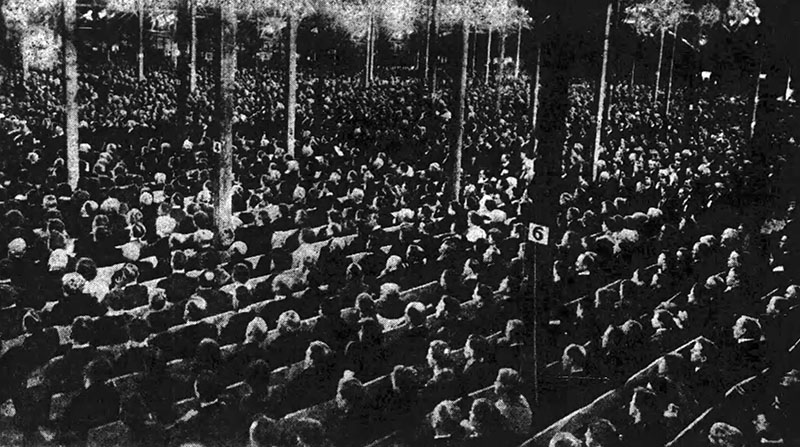
Crowds on January 29, 1917. Image source: Buffalo Evening News
Notably absent from the excitement was the Catholic Church, which in Buffalo discouraged its parishioners from attending the meetings: "Mr. Sunday is preaching a defective, incomplete Christianity." Sunday had no interest in churches he called his enemies, Christian Scientists and Universalists.
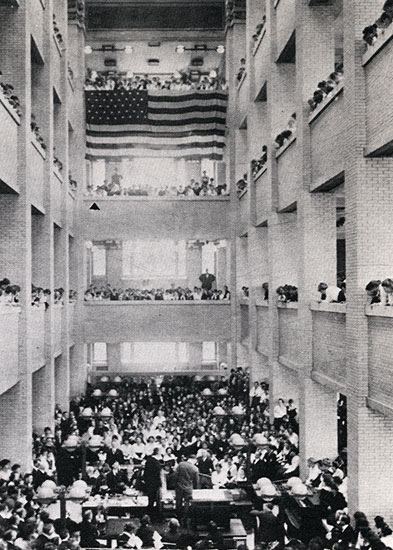
Billy Sunday speaking to Larkin employees in the Larkin Administration Building, 1917.
Image source: TBHM
Attendance was initially from high interest and curiosity. The Buffalo committee's general chairman, Volney Kinne, owner of a clothing shop and laundry, called for attendees to come to the first meeting and donate $10,000; this was accomplished and was the largest sum ever collected on a first night. Buffalo newspapers lavishly covered the campaign, usually with multiple columns beginning on the front page.
The Buffalo Daily Courier said on January 29 of Sunday's performance, "He seemed to lose all control of his emotions and for the moment he was the caveman of prehistoric times, fighting to the last ditch for what he believed was right and just...The curiosity-seekers in the audience who came to see Sunday's antics got their fill. Suddenly the evangelist would leap forward like a boxer to take advantage of an opening. One second he was at one end of the platform and you just got your head turned to watch him when he was at the other end. Then in a second he was in the center and hitting the pulpit solar plexus blows which would kill an ox."
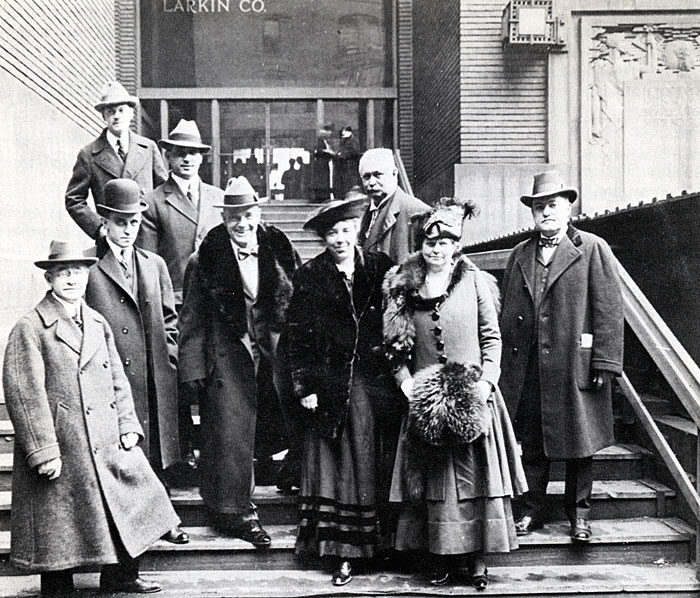
Billy and Ma Sunday (center) surrounded by Sunday staff and Larkin executives (Darwin Martin center rear). Image source: TBHM.
During his eight weeks in Buffalo, the audiences who turned up six days a week for the three-hour services were comprised of "delegations," groups of men, women and children who filled the cavernous room heated by 56 stoves and furnaces. Some people came for the day with their lunch; 8,500 Masons came; 6,500 high school and college students came on Student Night. Some delegations brought their own bands, many brought gifts and baskets of flowers. One of Buffalo's blizzards dampened attendance for a day.
At the end of the campaign, March 25, 1,020,440 had attended Sunday's meetings. Billy Sunday and his organization took away from the city a check for $42,204.74. The tabernacle demolition contract was awarded to a Bowmansville lumber dealer. The fixtures and stoves were auctioned off. The choir chairs were sold for $.75 to choir members and souvenir collectors. The sawdust that had covered the floor was baled and sold to fortune-hunters who would sift it for lost coins, watches and other valuables. In 1935, Buffalo organizers recalled that they made $8,000 after expenses.The baseball field was ready on opening day, May 3. (In 1924, Offerman Stadium would be built at this location and serve the Bisons until 1962 when it was demolished and Woodlawn Junior High School constructed thereday. Today, it is the Buffalo Academy for the Visual and Performing Arts.)
What was the result of the 8-week campaign? Very few converts to be "conserved" by churches, according to the churches involved. Volney Kinne joined the Billy Sunday organization after the 1917 campaign and worked at subsequent campaigns in other cities.
But one man, a 28-year old insurance salesman named Clinton H. Churchill, was converted by Sunday and became a "trail hitter," Sunday's term for those willing go out and convert others. He was ordained as a Methodist Episcopal minister and eventually opened a tabernacle on Lafayette St and Grant. Successful at this, he built a larger tabernacle, seating 3,200 at 1490 Main Street, opening in 1924. Two years later, he established a radio station, WKBW, to broadcast his message. (The call letters stand for "Well Known Bible Witness.") When Billy Sunday returned to Buffalo in 1919 for an 11-day campaign, he held it at the Churchill Evangelistic Tabernacle. And George Gowing, who had organized the three choirs for the 1917 campaign, became the music director for Churchill's Tabernacle.
Billy Sunday died in 1935 at age 72. His popularity had waned as new evangelists emerged, like Aimee Simple McPherson, with more sophisticated personas who used new technologies to communicate. In 1927, Sinclair Lewis used Billy Sunday and McPherson as inspiration for his satiric novel, "Elmer Gantry." Sunday was outraged at the similarities, but he achieved a kind of immortality because the novel was made into a movie in 1960 starring Burt Lancaster in the Billy Sunday role that won him an Academy Award.
Here is what Billy Sunday said in a sermon: "Listen, I'm against sin. I'll kick it as long as I've got a foot, I'll fight it as long as I've got a fist, I've butt it as long as I've got a head, and I'll bite it as long as I've got a tooth. And when I'm old, fistless, footless, and toothless, I'll gum it till I go home to glory and it goes home to perdition.”
Here are the lines Burt Lancaster delivered in the film, "Elmer Gantry": "As long as I got a foot, I'll kick booze. And, as long as I got a fist, I'll punch it. And, as long as I got a tooth, I'll bite it. And, when I'm old and gray and toothless and bootless, I'll gum it till I go to heaven and booze goes to hell."
And the Churchill Evangelistic Tabernacle? It became the home of WKBW radio and television. (More information here)
Part of the research for this story utilized an article by Mary Berenbaum in the Fall 1975 issue of Niagara Frontier, (a quarterly publication of the Buffalo & Erie County Historical Society, today known as The Buffalo History Museum).